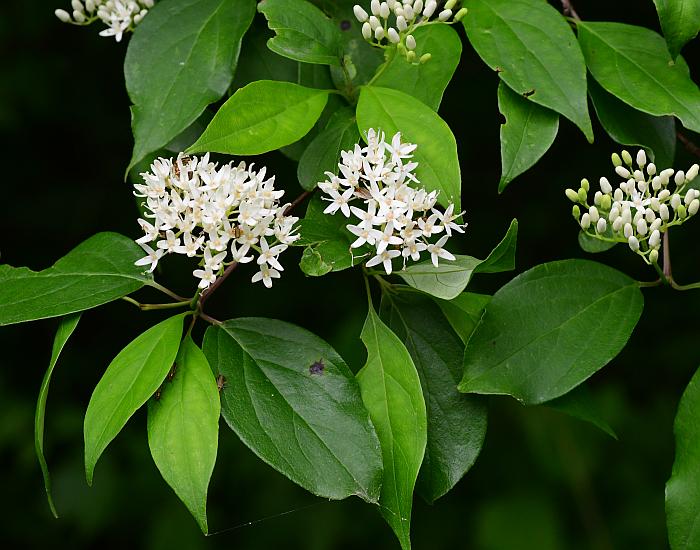Cornus foemina Mill.
Gray Dogwood

Native
CC = Amb
CW = Amb
MOC = 66
© SRTurner
Cornus foemina Mill.Gray Dogwood | |
 |
Native CC = Amb CW = Amb MOC = 66 |
© SRTurner |
|
Family - Cornaceae Habit - Shrub or small tree to 8 m, not rhizomatous. Stems - Multiple from the base. Bark gray-brown, becoming gray-black, smooth or longitudinally fissured, the ridges becoming divided into thin irregular plates. Twigs deep red, often pale green abaxially, or completely green if shaded, sparsely to densely pubescent. Lenticels pale circular spots on new growth, often locally overlapping to form longitudinal bands. Leaves - Opposite, simple, petiolate, well-distributed along branches. Petioles 5-15 mm, densely pubescent. Blades 5-12 cm long, 2-7 cm wide, broadly lanceolate to elliptic or ovate, rounded, angled, or short-tapered at the base, sharply pointed, the surfaces glabrous or sparsely to moderately pubescent with mostly appressed, straight, T-shaped hairs, the undersurface sometimes with microscopic white papillae and slightly roughened to the touch, the lateral veins 3 or 4 pairs, these relatively evenly spaced, the basal vein arising 1-2 mm from blade base.
Inflorescences - Flat-topped or domed cymes 2-8 cm in diameter, the peduncles 15-45 mm. Branches and pedicels greenish yellow, turning red in fruit.
Flowers - Hypanthia densely appressed-hairy. Sepals 4, 0.4-1 mm. Petals 4, cream, 2.6-3.8 mm. Stamens 4, alternating with petals, erect, exserted. Filaments to 4 mm long, whitish, glabrous. Anthers yellowish, 1.1 mm long. Style glabrous, whitish, 2.2 mm long. Style 2-3 mm long, relatively slender, not broadened toward the tip. Stigma capitate. Ovary inferior, 2-locular.
Fruits - Globose drupes 4-7 mm in diameter, pale blue, or blue violet, often turning to white, on red stalks. Stone globose to oblong, 3-5 mm, slightly ribbed, the apex rounded. Flowering - May - June. Habitat - Bottomland forests, marshes, swamps, streambanks, pond margins, fens, seeps, wet ditches. Origin - Native to the U.S. Lookalikes - Cornus drummondii, Cornus racemosa. Other info. - This shrub occurs mostly in the Bootheel region of Missouri, and across much the southeastern U.S. and Deep South. It is a denizen of wet places and, in addition to habitat preference, is recognized by having clustered stems, leaves with at most 4 pairs of lateral veins, and leaf lower surfaces having strongly appressed, typically T-shaped hairs. Photographs taken at Mingo NWR, Stoddard County, MO, 5-23-2022 (SRTurner). |